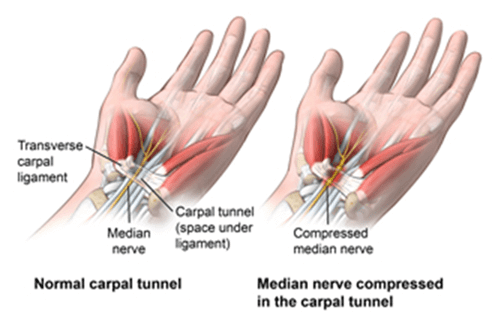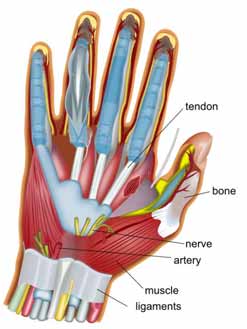
Why poorly fitting gloves can cause Musculoskeletal Disorders and how to prevent it?
As part of protective equipment, many workers must wear gloves in different work areas to protect their hands. Personal protective equipment (PPE) is necessary to perform their job and ensure their safety.
Many people do not give a lot of importance to the choice of gloves and wear what is provided to them. Making the right choice of gloves provides optimal comfort, improved tactile sensitivity and prevents hand fatigue. Conversely, making the wrong choice of gloves could lead to poor performance, increased hand fatigue and an increased risk of developing musculoskeletal disorders (MSDs)
Wearing gloves is an important part of personal protection at work, it can limit the grip strength, dexterity and tactile sensitivity necessary compared to the same task performed with bare hands. We know that the ultimate goal of wearing gloves is first and foremost to protect the worker so that they can perform a specific task safely. Several options are available, and criteria are key elements in the final decision-making process. Depending on the work to be done, the thickness, material, size and fit of the gloves should be taken into consideration.
Gloves should fit like a comfortable second skin on the palm and full length to the fingertips. If the glove is too short to fit the fingers or too tight on the palm, flexibility and freedom of movement are compromised. Conversely, a glove that is too large and unsuitable will be uncomfortable and could reduce performance and efficiency.
The normal functioning of a hand is ensured by the combined interaction of its various parts, which together form a complex unit [Medical MultiMedia Group, 2003]. The main parts of a hand can be divided into five major categories, namely, bones and joints, ligaments and tendons, muscles, nerves and blood vessels and, of course, the layer of skin protecting the hand as a whole.
Anatomical representation of a hand (illustration adapted from Wikimedia Commons)
The hand and the wrist together contain 27 bones. The way these bones are aligned with one another is critical. Also, the extremities of the joints are covered with articular cartilage, whose function is to cushion impact and provide an extremely smooth surface facilitating the relative motion of the bones. Ligaments connect bones together and align the relative motion of the bones while limiting their amplitude. Muscles control hand motion, especially that of the wrist and fingers. For example, they allow one to grab and hold an object. One function of the tendons is to enable fingers to bend and straighten out. Nerves transmit information between the hand and the brain. In one direction, signals from the brain activate muscles and consequently hand motion. In the other direction, nerves transmit information to the brain concerning sensations such as touch, pain, and temperature. Alongside the nerves, there are large vessels supplying the hand with blood. Hands are indispensable if an individual wishes to be autonomous. They are fragile and irreplaceable, and they require care and protection.
A worker’s hand should not be affected by movement, tension and fatigue when wearing gloves. Daily hand fatigue can cause musculoskeletal disorders (MSDs) such as the carpal tunnel, which can cause pain and interfere with the proper functioning of the hands. The right choice of gloves is an important element in the prevention of musculoskeletal disorders.
 Lorsque vous regardez tous les choix de gants disponibles parmi les différentes épaisseurs, le type de matériau, l’ajustement et la taille, pour n’en nommer que quelques-uns, chez Aurelia Healthcare Canada nous suggérons d’essayer plusieurs gants avec des propriétés différentes pour trouver celui qui vous convient.
Lorsque vous regardez tous les choix de gants disponibles parmi les différentes épaisseurs, le type de matériau, l’ajustement et la taille, pour n’en nommer que quelques-uns, chez Aurelia Healthcare Canada nous suggérons d’essayer plusieurs gants avec des propriétés différentes pour trouver celui qui vous convient.
Voici quelques conseils pour garder vos mains en santé pendant que vous réalisez votre travail journalier (insert link when online), ainsi qu’un article pour illustrer la différence entre l’usage du savon et du désinfectant à mains. Si vous recherchez le gant parfait pour vous, suivez nos conseils pour choisir le gant qui vous conviendra le mieux, et renseignez-vous sur les différents types de gants disponibles!
Voici un lien vers le site Web d’Aurelia Gloves Canada et n’hésitez pas à regarder les choix de gants et à faire une demande d’échantillons de certains de nos gants Aurelia premium pour vous aider à faire le bon choix!
When you look at all the choices of gloves available among the different thicknesses, material type, fit and size, to name a few, at Aurelia Healthcare Canada we suggest trying several gloves with properties to find the one that’s right for you.
Here are a couple tips from our team to keep you hands healthy while performing your work (insert link when online) as well as an article comparing hand sanitizer vs. hand washing routines. Now, if you’re looking to find the best glove for YOU, check out how to choose the glove that will best fit your needs, and get some info about the different types of gloves available!
Also, here is a link to the Aurelia Gloves Canada website and feel free to look at the choice of gloves and request a sample of some of our premium Aurelia gloves to help you make the right choice!


